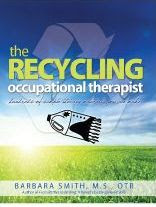Successful Hand Skills Contibutes to Learning!
I have been very impressed with the OT MOM Learning Activities website . Occupational therapist and homeschooling mom Tracey Le Roux describes many tricks of the trade in a fun easy to understand manner both on her website and in her ebooks. The many photographs and detailed descriptions demonstate the activities that help children develop and refine motor skills. This actually sounds similar to my book- From Rattles to Writing: A Parent's Guide to Hand Skills. However, the OT Mom focuses on the many common problems OTs come across and how to prevent and/or fix them. My book, on the other hand, focuses on typical development and how to prepare children for kindergarten beginning at birth by providing the sensory, motor, cognitive, language and social experiences that promote learning.
 Many of the activities described on the OT mom'swebsite are included in her books and I'm sure many readers appreciate the free and readily available on-line information. However, the purchase of an ebook for only $7.50 not only contributes to maintaining a very useful website, but provides a much more comprehensive resource.
Many of the activities described on the OT mom'swebsite are included in her books and I'm sure many readers appreciate the free and readily available on-line information. However, the purchase of an ebook for only $7.50 not only contributes to maintaining a very useful website, but provides a much more comprehensive resource.OT Mom' Fine-Motor Activities
This is what I like about the OT Mom's Fine Motor Activities book:
Fine motor skills are broken down into 4 basic areas with corresponding in depth- explanations on terminology, problem areas and solutions.
- Postural Control
- Touch Perception
- Hand and Finger Muscles
- Bilateral Coordination
Tracey gives nice easy to follow strategies to address problems such as grasping a pencil too tightly, neglecting one hand or hooking the wrist while writing or cutting. But I think that the best part of the book is the detailed descriptions of how to therapeutically use ordinary, fun activities made out of readily available materials such as play dough, paper, sponges spray bottles, peg boards, piggy banks, clothes pins, bean bags or balls. The many photos and narrative show the reader how to get the most therapeutic result from each activity. This 70 page resource also includes appendices with additional activities to develop postural control, sensory perception and bilateral coordination and a tip sheet for fitting fine-motor activities into a child's daily activities.

The OT Mom's Scissor cutting Skills book is obviously focused on this one demanding and complex skill. There are many reasons why a child struggles with using scissors and Tracey does a wonderful job of describing solutions to challenges such as -
1. inefficient grasp
2. cutting in the wrong or an inefficient direction
3. poor bilateral coordination
4. inaccuracy in cutting on lines
The OT Mom's next step is describing the activities that develop the motor skills used in cuttings- such as coordinating the grasp/release motions and developing rhythmic sequentil movements. Graded adaptions help children progress from cutting on lines, circles, simple shapes and finally complex shapes.
Not every child performs a motor task in the same way and its not always clear whether or not the child has a problem that needs to be addressed. The OT Mom's fine-motor cutting check-list is designed to help parents and teachers discriminate functional cutting skills vs. problem areas to address. The clear directions and photos in this 23 page ebook will help children develop the fine motor skills they need to successfully use scissors.
After reading these 2 books by the OT Mom it is obvious that she shares my motto!
Successful Hand Skills Contibute to Learning!






 I
I






 I
I 







